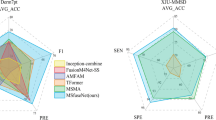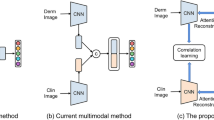Abstract
Skin disease cases are rising in prevalence, and the diagnosis of skin diseases is always a challenging task in the clinic. Utilizing deep learning to diagnose skin diseases could help to meet these challenges. In this study, a novel neural network is proposed for the classification of skin diseases. Since the datasets for the research consist of skin disease images and clinical metadata, we propose a novel multimodal Transformer, which consists of two encoders for both images and metadata and one decoder to fuse the multimodal information. In the proposed network, a suitable Vision Transformer (ViT) model is utilized as the backbone to extract image deep features. As for metadata, they are regarded as labels and a new Soft Label Encoder (SLE) is designed to embed them. Furthermore, in the decoder part, a novel Mutual Attention (MA) block is proposed to better fuse image features and metadata features. To evaluate the model’s effectiveness, extensive experiments have been conducted on the private skin disease dataset and the benchmark dataset ISIC 2018. Compared with state-of-the-art methods, the proposed model shows better performance and represents an advancement in skin disease diagnosis.








Similar content being viewed by others
Explore related subjects
Discover the latest articles and news from researchers in related subjects, suggested using machine learning.References
He, K., Zhang, X., Ren, S., Sun, J.: Deep residual learning for image recognition. In: Proceedings of the IEEE Conference on Computer Vision and Pattern Recognition, pp. 770–778 (2016)
Huang, G., Liu, Z., Van Der Maaten, L., Weinberger, K.Q.: Densely connected convolutional networks. In: Proceedings of the IEEE Conference on Computer Vision and Pattern Recognition, pp. 4700–4708 (2017)
Xiao, H., Ran, Z., Mabu, S., Li, Y., Li, L.: SAUNet++: an automatic segmentation model of COVID-19 lesion from CT slices. Vis. Comput. pp. 1–14 (2022)
Mohamed, E.H., El-Behaidy, W.H.: Enhanced skin lesions classification using deep convolutional networks. In: 2019 Ninth International Conference on Intelligent Computing and Information Systems (ICICIS), IEEE, pp. 180–188 (2019)
Zhang, Y., Wang, C.: SIIM-ISIC melanoma classification with DenseNet. In: 2021 IEEE 2nd international conference on big data, artificial intelligence and internet of things engineering (ICBAIE), IEEE, pp. 14–17 (2021)
Karthik, K., Kamath, S.S.: A deep neural network model for content-based medical image retrieval with multi-view classification. Vis. Comput. 37(7), 1837–1850 (2021)
Wang, W., et al.: Pyramid vision transformer: a versatile backbone for dense prediction without convolutions. arXiv preprint arXiv:2102.12122 (2021)
Yang, J., et al.: Focal self-attention for local-global interactions in vision transformers. arXiv preprint arXiv:2107.00641 (2021)
Liu, Z., et al.: Swin transformer: Hierarchical vision transformer using shifted windows. arXiv preprint arXiv:2103.14030 (2021)
Zhang, Z., Zhang, H., Zhao, L., Chen, T., Pfister, T.: Aggregating nested transformers. arXiv preprint arXiv:2105.12723 (2021)
Chen, C-F., Fan, Q., Panda, R.: Crossvit: cross-attention multi-scale vision transformer for image classification. arXiv preprint arXiv:2103.14899 (2021)
Dosovitskiy, A., et al.: An image is worth 16x16 words: transformers for image recognition at scale, arXiv preprint arXiv:2010.11929 (2020)
Simonyan, K., Zisserman, A.: Very deep convolutional networks for large-scale image recognition. arXiv preprint arXiv:1409.1556 (2014)
Tan, M., Le, Q.: Efficientnet: rethinking model scaling for convolutional neural networks. In: International Conference on Machine Learning, PMLR, pp. 6105–6114 (2019)
Vaswani, A., et al.: Attention is all you need. In: Advances in neural information processing systems, pp. 5998–6008 (2017)
Phung, S.L., Bouzerdoum, A., Chai, D.: Skin segmentation using color pixel classification: analysis and comparison. IEEE Trans. Pattern Anal. Mach. Intell. 27(1), 148–154 (2005)
Zhang, J., Xie, Y., Wu, Q., Xia, Y.: Medical image classification using synergic deep learning. Med. Image Anal. 54, 10–19 (2019)
Gao, X., Zhang, Y., Wang, H., Sun, Y., Zhao, F., Zhang, X.: A modified fuzzy clustering algorithm based on dynamic relatedness model for image segmentation. Vis. Comput. pp. 1–14 (2022)
Serte, S., Demirel, H.: Gabor wavelet-based deep learning for skin lesion classification. Comput. Biol. Med. 113, 103423 (2019)
Javed, R., Saba, T., Shafry, M., Rahim, M.: An intelligent saliency segmentation technique and classification of low contrast skin lesion dermoscopic images based on histogram decision. In: 2019 12th International Conference on Developments in eSystems Engineering (DeSE), IEEE, pp. 164–169 (2019)
Salah, K.B., Othmani, M., Kherallah, M.: A novel approach for human skin detection using convolutional neural network. Vis. Comput. 38, 1–11 (2021)
Hao, Y., et al.: An end-to-end model for question answering over knowledge base with cross-attention combining global knowledge. In: Proceedings of the 55th Annual Meeting of the Association for Computational Linguistics (Volume 1: Long Papers), pp. 221–231 (2017)
Gonzalez-Diaz, I.: Dermaknet: Incorporating the knowledge of dermatologists to convolutional neural networks for skin lesion diagnosis. IEEE J. Biomed. Health Inform. 23(2), 547–559 (2018)
Song, L., Lin, J., Wang, Z.J., Wang, H.: An end-to-end multi-task deep learning framework for skin lesion analysis. IEEE J. Biomed. Health Inform. 24(10), 2912–2921 (2020)
Tang, P., Liang, Q., Yan, X., Xiang, S., Zhang, D.: Gp-cnn-dtel: Global-part cnn model with data-transformed ensemble learning for skin lesion classification. IEEE J. Biomed. Health Inform. 24(10), 2870–2882 (2020)
Kawahara, J., Daneshvar, S., Argenziano, G., Hamarneh, G.: Seven-point checklist and skin lesion classification using multitask multimodal neural nets. IEEE J. Biomed. Health Inform. 23(2), 538–546 (2018)
Pacheco, A.G.C., Krohling, R.: An attention-based mechanism to combine images and metadata in deep learning models applied to skin cancer classification. IEEE J. Biomed. Health Inform. (2021)
Zhou, L., Luo, Y.: Deep features fusion with mutual attention transformer for skin lesion diagnosis. In: Presented at the 2021 IEEE International Conference on Image Processing (ICIP) (2021)
Gessert, N., Nielsen, M., Shaikh, M., Werner, R., Schlaefer, A.: Skin lesion classification using ensembles of multi-resolution EfficientNets with meta data. MethodsX 7, 100864 (2020)
Höhn, J., et al.: Integrating patient data into skin cancer classification using convolutional neural networks: systematic review. J. Med. Internet Res. 23(7), e20708 (2021)
Ningrum, D.N.A., et al.: Deep learning classifier with patient’s metadata of dermoscopic images in malignant melanoma detection. J. Multidiscip. Healthc. 14, 877 (2021)
Pacheco, A.G., Krohling, R.A.: An attention-based mechanism to combine images and metadata in deep learning models applied to skin cancer classification. IEEE J. Biomed. Health Inform. 25(9), 3554–3563 (2021)
Kim, J.-H., On, K.-W., Lim, W., Kim, J., Ha, J.-W., Zhang, B.-T.: Hadamard product for low-rank bilinear pooling. arXiv preprint arXiv:1610.04325 (2016)
Kim, J.-H., Jun, J., Zhang, B.-T.: Bilinear attention networks. arXiv preprint arXiv:1805.07932 (2018)
Xiong, C., Merity, S., Socher, R.: Dynamic memory networks for visual and textual question answering. In: International Conference on Machine Learning, PMLR, pp. 2397–2406 (2016)
Bose, R., Pande, S., Banerjee, B.: Two headed dragons: multimodal fusion and cross modal transactions. In: 2021 IEEE International Conference on Image Processing (ICIP), IEEE, pp. 2893–2897 (2021)
Tschandl, P., Rosendahl, C., Kittler, H.: The HAM10000 dataset, a large collection of multi-source dermatoscopic images of common pigmented skin lesions. Sci. Data 5(1), 1–9 (2018)
Codella, N., et al.: Skin lesion analysis toward melanoma detection 2018: a challenge hosted by the international skin imaging collaboration (isic). arXiv preprint arXiv:1902.03368 (2019)
Yu, Z., Yu, J., Fan, J., Tao, D.: Multi-modal factorized bilinear pooling with co-attention learning for visual question answering. In: Proceedings of the IEEE international conference on computer vision, pp. 1821–1830 (2017)
Khan, M.A., Javed, M.Y., Sharif, M., Saba, T., Rehman, A.: Multi-model deep neural network based features extraction and optimal selection approach for skin lesion classification. In: 2019 international conference on computer and information sciences (ICCIS), IEEE, pp. 1–7 (2019)
Huang, H.W., Hsu, B.W.Y., Lee, C.H., Tseng, V.S.: Development of a light-weight deep learning model for cloud applications and remote diagnosis of skin cancers. J. Dermatol. 48(3), 310–316 (2021)
Liu, Q., Yu, L., Luo, L., Dou, Q., Heng, P.A.: Semi-supervised medical image classification with relation-driven self-ensembling model. IEEE Trans. Med. Imaging 39(11), 3429–3440 (2020)
Gu, Y., Ge, Z., Bonnington, C.P., Zhou, J.: Progressive transfer learning and adversarial domain adaptation for cross-domain skin disease classification. IEEE J. Biomed. Health Inform. 24(5), 1379–1393 (2019)
Acknowledgements
This research is supported in part by Science and Technology Commission of Shanghai Municipality (20DZ2254400, 21DZ2200600), National Scientific Foundation of China (82170110), Zhongshan Hospital Clinical Research Foundation(2019ZSGG15), and Shanghai Pujiang Program (20PJ1402400).
Author information
Authors and Affiliations
Corresponding authors
Additional information
Publisher's Note
Springer Nature remains neutral with regard to jurisdictional claims in published maps and institutional affiliations.
Rights and permissions
About this article
Cite this article
Cai, G., Zhu, Y., Wu, Y. et al. A multimodal transformer to fuse images and metadata for skin disease classification. Vis Comput 39, 2781–2793 (2023). https://doi.org/10.1007/s00371-022-02492-4
Accepted:
Published:
Issue Date:
DOI: https://doi.org/10.1007/s00371-022-02492-4
Keywords
Profiles
- Yu Zhu View author profile




